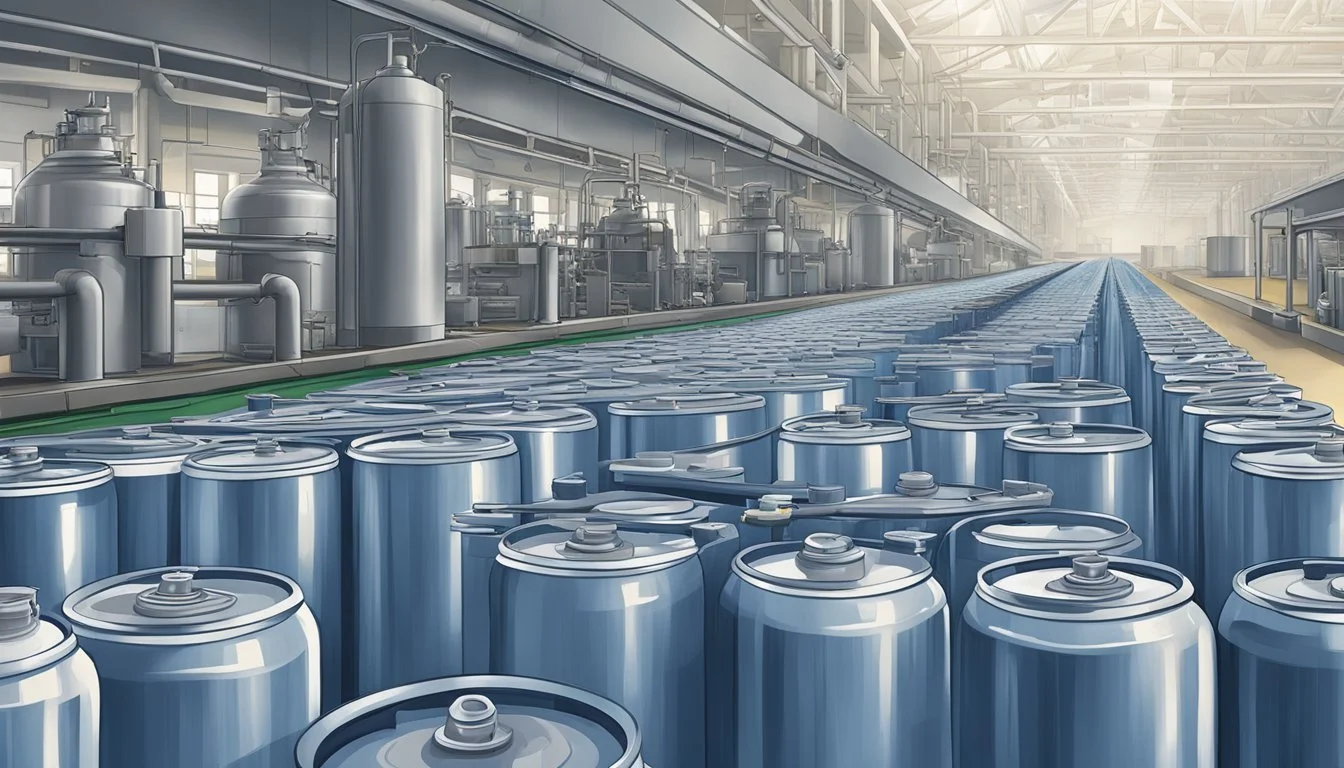Aquafina vs. The Well
A Clear Comparison of Bottled Water Choices
Choosing the right bottled water can significantly impact your daily hydration habits. Among the many options available, Aquafina and The Well stand out as popular choices. Aquafina, produced by PepsiCo, is known for its stringent purification process, which results in crisp, clean water. On the other hand, The Well boasts its natural water sources and minimal processing to retain essential minerals, providing a more natural taste.
When it comes to taste and purity, the differences are noteworthy. Aquafina offers a consistently clean flavor, appealing to those who prefer a neutral taste. The Well, with its retained minerals, offers a slightly more complex flavor profile that might resonate with consumers looking for water that tastes closer to nature.
Each brand brings unique attributes that cater to different preferences. Aquafina’s widespread availability and taste consistency make it a reliable choice for many, while The Well's natural mineral content might appeal to those seeking a more organic option. Understanding these distinctions can help consumers make an informed decision tailored to their hydration needs.
Assessing Water Quality
To evaluate the quality of Aquafina and The Well bottled water, specific factors such as purity, contaminant levels, mineral composition, pH levels, alkalinity, and overall health benefits will be examined. This approach offers a thorough insight into what makes each water brand distinct and reliable for consumers.
Purity and Contaminant Levels
Aquafina emphasizes its 7-step HydRO-7 filtration process, aiming to remove more contaminants than typical bottled waters. This comprehensive filtration targets a reduction of substances such as chlorine, salts, and other impurities.
The Well, meanwhile, uses advanced purification methods that include multiple stages of filtration and UV treatment to ensure high purity. Both brands are tested regularly for contaminants like PFAS chemicals, ensuring safety for consumers.
Mineral Composition
Mineral content in bottled water can affect both taste and health benefits. Aquafina is known to have very low mineral content, as it primarily focuses on removing impurities, which leaves it with a clean but less distinctive taste.
The Well incorporates essential minerals like calcium and magnesium to enhance the flavor and nutritional value. The added minerals in The Well not only improve the taste but can also be beneficial for maintaining electrolytes in the body.
pH Levels and Alkalinity
pH levels and alkalinity of bottled waters can influence their overall health impacts. Aquafina has a slightly acidic pH level, usually around 5, comparable to a cup of black coffee. This may cause some concern for those looking for more balanced alkaline water for health reasons.
The Well, on the other hand, maintains a more neutral pH level, closer to 7, which is considered more beneficial for regular consumption. Alkaline water is often preferred by those looking to balance their body's pH levels and offset acidity.
Comparing Bottled Waters
When compared to other popular bottled waters like Dasani, Evian, Fiji, Smartwater, Pure Life, and Essentia, both Aquafina and The Well hold up well.
Dasani adds mineral salts for taste, while Evian and Fiji are known for their naturally high mineral contents. Smartwater emphasizes vapor-distilled purity.
Pure Life and Essentia focus on high alkalinity and added electrolytes.
Each brand has its own strengths, making it essential for consumers to consider what factors are most important to them, whether it be purity, flavor, or health benefits.
Hydration and Health Benefits
The quality of bottled water directly impacts its health benefits. Aquafina, due to its rigorous filtration process, provides a pure and safe hydration option.
The Well, with its balanced pH and mineral content, not only hydrates but also supports electrolyte balance and overall health.
Consumers seeking specific health benefits should consider the unique properties of each brand, especially regarding mineral content and pH levels, to choose the best option for their needs.
Understanding Water Sources
When evaluating bottled water options, it's crucial to understand the origins and treatment processes that differentiate them. This section compares different sources and treatments, shedding light on what makes each type unique.
Spring Water vs. Purified Water
Spring water and purified water differ mainly in their origin and treatment. Spring water, like that from Arrowhead or Deer Park, comes from natural springs or underground springs. It flows to the surface naturally and often passes through volcanic rock, which adds minerals.
In contrast, purified water, such as Aquafina or The Well, starts as tap water. This water undergoes extensive treatment to remove impurities. For example, Aquafina uses a HydRO-7 purification process that includes various stages to achieve high purity levels.
Treatment Processes
The treatment processes for bottled water can significantly affect its quality and taste. Spring water usually undergoes minimal treatment, aiming to preserve its natural mineral content and taste. Brands like Arrowhead collect water directly from sources and implement filtration to ensure safety without stripping away beneficial minerals.
Purified water, on the other hand, goes through rigorous processes. Aquafina, for instance, employs reverse osmosis as part of its HydRO-7 purification. This method involves forcing water through a semipermeable membrane, removing contaminants and achieving a high level of purity. This process ensures consistency in taste but may lack the unique mineral profile found in natural sources.
Understanding these differences helps consumers make informed choices based on the water's origin and treatment.
Environmental Considerations
Choosing between Aquafina and The Well requires understanding their environmental impact, focusing on packaging and sustainability practices.
Packaging Impact
Aquafina uses plastic bottles that are fully recyclable, yet the environmental impact of plastic remains a concern. Despite recycling options, plastic waste continues to affect ecosystems if not managed properly. Being conscious of the carbon footprint associated with producing and transporting these bottles is essential.
The Well aims to be more environmentally friendly by exploring plant-based packaging. This reduces reliance on traditional plastics, minimizing environmental impact. Additionally, The Well emphasizes recyclable materials, aligning with sustainability goals and reducing the long-term environmental footprint.
Water Brand Sustainability Practices
Aquafina, produced by PepsiCo, highlights its efforts in reducing the carbon footprint through improved processes and sustainable practices. They focus on reducing water usage in their production facilities and are actively engaging in reforestation projects to offset their environmental impact.
The Well, a smaller brand, champions a more holistic sustainability approach. They prioritize using local water sources to reduce transportation emissions and emphasize using renewable energy in their operations. Their sustainability practices aim to ensure a minimal environmental footprint, appealing to eco-conscious consumers.
Taste Evaluation
Aquafina and The Well present distinct taste profiles that cater to different palates.
Aquafina is known for its clean, crisp taste. The purification process removes impurities, providing a neutral water taste that many find refreshing. There is a slightly metallic aftertaste, but it is not overly pronounced.
In contrast, The Well offers a more natural taste. The water is sourced from natural springs, giving it a mineral-rich profile. This results in a subtle, earthy flavor that some may find more appealing.
Both brands are free from any strong plastic or chemical tastes, making them reliable choices for daily hydration.
A brief taste comparison can be laid out as follows:
Criteria Aquafina The Well Cleanliness Clean and crisp Natural and earthy Aftertaste Slightly metallic Subtle mineral notes
Their taste profiles reflect their respective source and treatment processes. Hence, the choice between Aquafina and The Well may come down to personal preference on taste.
Production and Bottling Methods
Aquafina and The Well have distinct approaches to their production and bottling processes, each emphasizing purity and regulatory compliance.
Filtration and Sterilization
Aquafina employs a sophisticated purification process known as HydRO-7, which includes multiple steps like reverse osmosis, carbon filtration, and ultraviolet light exposure. This extensive filtration is designed to remove contaminants, ensuring the water is pure and has a crisp taste. Ozone sterilization is often used to further eliminate any potential microorganisms before bottling.
In contrast, The Well may use a combination of methods such as ultraviolet light and carbon filters to cleanse the water. These techniques aim to achieve similar results in terms of purity. Ozone is also likely applied to sterilize the water, ensuring it meets the highest hygienic standards before bottling.
Labeling and Regulatory Compliance
Both Aquafina and The Well must adhere to stringent FDA regulations. These regulations require accurate labeling, proving the water’s purity and safety. The labeling includes detailed information about the water source and the purification methods used.
Aquafina labels its bottles with specific details about its HydRO-7 purification process. They list any mineral additions for taste enhancement, ensuring transparency with consumers. The Well likely follows similar protocols, detailing their filtration and sterilization methods to maintain customer trust and compliance with federal guidelines.
Compliance with FDA standards extends beyond labeling, affecting every step from bottling to distribution. Both companies must maintain meticulous records demonstrating adherence to FDA regulations, ensuring their waters are not only safe to consume but also accurately represented in their marketing and packaging.
The Industry and Consumer Choice
Choosing the right bottled water involves examining market dynamics and pricing. This section addresses market trends and brand comparisons, and explores economic factors influencing pricing.
Market Overview and Brand Comparison
The bottled water industry is a significant segment of the beverage market, led by major companies like Coca-Cola, PepsiCo, and Nestlé. Coca-Cola's Dasani and PepsiCo's Aquafina are two prominent brands, both known for their extensive purification processes.
Aquafina, due to its purification, offers a very clean taste. The Well, by comparison, is marketed as premium water, emphasizing natural minerals and a refreshing profile.
Consumers often choose between these brands based on perceived quality, branding, and availability in grocery stores. Smaller brands may offer unique attributes but lack the broad market reach of leading water brands.
Economic Aspects and Pricing
The price of bottled water varies considerably based on the brand and its market positioning. Aquafina and The Well serve different economic niches; Aquafina is generally more accessible and moderately priced due to its mass production by PepsiCo.
In contrast, The Well positions itself as a luxury product, with higher pricing reflecting its premium branding and purportedly superior mineral content.
In grocery stores, consumers' purchasing decisions can be swayed by discounts, bulk pricing, and brand loyalty programs. The economic landscape of the bottled water industry is influenced by production costs, marketing strategies, and consumer buying power.
Health and Safety Considerations
Understanding the minerals and additives, as well as the certifications and safety measures, is crucial when comparing Aquafina and The Well bottled waters.
Minerals and Additives
Different bottled waters contain varying levels of electrolytes and minerals like magnesium, calcium, potassium, and sodium, which can impact both taste and health benefits.
Aquafina undergoes a purification process that strips most natural minerals, resulting in minimal electrolyte content. It is known for being one of the more acidic bottled waters, with a pH level around 5. This acidity is comparable to that of a cup of black coffee.
The Well, depending on its source, may retain more natural minerals which can contribute to superior hydration and a balanced pH. The presence of antioxidants in some bottled waters, including The Well, may offer additional health benefits by neutralizing free radicals.
Certifications and Water Safety
Water safety certifications ensure bottled water meets high standards for purity and health.
Aquafina adheres to the FDA's highest standards for bottled water, utilizing a multi-step purification process including reverse osmosis. This process is effective at removing lead, heavy metals, and other contaminants, ensuring clean and safe drinking water.
The Well is sourced from natural springs and often boasts certifications like the NSF International or IBWA standards, which also focus on removing impurities and maintaining high-quality water. These certifications provide assurance that the water is free from harmful substances and safe to consume.





